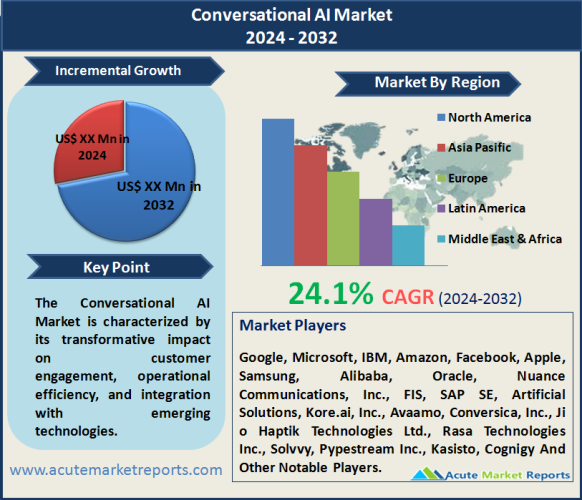
The conversational AI market is witnessing unprecedented growth, transforming how businesses interact with customers and streamline internal processes. The conversational AI market is expected to grow at a CAGR of 24.1% during the forecast period of 2024 to 2032. The conversational AI market is characterized by its transformative impact on customer engagement, operational efficiency, and integration with emerging technologies. While the potential for biased responses poses a challenge, ongoing advancements in AI ethics and algorithmic refinement aim to address these concerns. The segmentation reveals dynamic shifts in component preferences, service models, and the types of conversational interfaces. Geographically, Asia-Pacific emerges as a key growth region, underscoring the global nature of conversational AI adoption. As top players continue their strategic initiatives, the conversational AI market is poised for continued expansion, playing a central role in reshaping digital interactions and service delivery across industries.

Enhanced Customer Engagement
A primary driver propelling the conversational AI market is the quest for enhanced customer engagement. Companies such as Google, Microsoft, and IBM have harnessed the power of conversational AI to create intelligent chatbots and virtual assistants that provide personalized and interactive experiences. Evidenced by increased customer satisfaction scores and positive feedback, the adoption of conversational AI enables businesses to establish meaningful connections with their audience. The ability to understand natural language, respond contextually, and offer real-time assistance contributes to a seamless and engaging customer experience, fostering brand loyalty and positive sentiment.
Operational Efficiency and Cost Savings
conversational AI drives operational efficiency and cost savings, making it a pivotal driver for businesses across industries. Companies like Amazon and Facebook utilize chatbots and virtual assistants to automate routine tasks, handle customer inquiries, and facilitate transactions. This automation results in significant time and cost savings, allowing human resources to focus on more complex and value-added activities. The evidence of this driver is observed in the increased adoption of conversational AI solutions, leading to streamlined workflows and improved overall efficiency.
Integration with Emerging Technologies
The integration of conversational AI with emerging technologies such as artificial intelligence (AI) and machine learning (ML) serves as a powerful driver. Leading companies like Apple, Samsung, and Alibaba leverage conversational AI to create intelligent virtual assistants capable of learning and adapting to user preferences over time. This driver is substantiated by the continuous advancements in natural language processing (NLP) and sentiment analysis, enabling conversational AI systems to understand and respond to user emotions and nuances effectively. The evolving synergy between conversational AI and cutting-edge technologies positions it as a transformative force in the digital landscape.
Restraint
Despite its remarkable growth, a notable restraint in the conversational AI market is the potential for biased or inaccurate responses. As demonstrated in instances involving chatbots and virtual assistants, biases in language understanding and response generation can occur, leading to unintended consequences. While companies actively work to address these issues, evidence of this restraint is seen in reported incidents where conversational AI systems provided inappropriate or biased responses. Striking the right balance between AI autonomy and ethical considerations remains a challenge, requiring ongoing refinement of algorithms and monitoring mechanisms.
Market Segmentation by Component: Solutions Segment Dominate the Market
The market is segmented into Solutions, Managed Services, and Professional Services. In 2023, Solutions dominated in terms of revenue, reflecting the widespread adoption of standalone conversational AI solutions. However, during the forecast period of 2024 to 2032, Managed Services are expected to exhibit the highest CAGR. This shift indicates a growing preference for outsourced management of conversational AI systems, emphasizing the need for continuous optimization, monitoring, and expertise to ensure peak performance.
Market Segmentation by Type: Chatbots Dominate the Market
conversational AI is segmented by type into Chatbots and Intelligent Virtual Assistants (IVA). In 2023, Chatbots led in both revenue and CAGR, reflecting their versatility in addressing a wide range of use cases. However, during the forecast period of 2024 to 2032, IVAs are expected to exhibit the highest CAGR. This shift signifies the increasing demand for more sophisticated virtual assistants capable of understanding complex queries and providing context-aware responses, enhancing the overall conversational experience.
North America Remains the Global Leader
Geographically, the conversational AI market exhibits dynamic trends. In 2023, North America led in both revenue and CAGR, driven by early adoption and substantial investments from key players. However, Asia-Pacific is expected to experience the highest CAGR during the forecast period. This shift is supported by the region's rapid digital transformation, rising technological awareness, and the integration of conversational AI in diverse industries.
Market Competition to Intensify during the Forecast Period
Top players in the conversational AI market include Google, Microsoft, IBM, Amazon, Facebook, Apple, Samsung, Alibaba, Oracle, Nuance Communications, Inc., FIS, SAP SE, Artificial Solutions, Kore.ai, Inc., Avaamo, Conversica, Inc., Jio Haptik Technologies Ltd., Rasa Technologies Inc., Solvvy, Pypestream Inc., Kasisto and Cognigy. These companies deploy diverse strategies such as continuous innovation, strategic partnerships, and expanding service offerings. In 2023, their revenues reflected market leadership, with expectations of sustained growth during the forecast period.
Historical & Forecast Period
This study report represents analysis of each segment from 2022 to 2032 considering 2023 as the base year. Compounded Annual Growth Rate (CAGR) for each of the respective segments estimated for the forecast period of 2024 to 2032.
The current report comprises of quantitative market estimations for each micro market for every geographical region and qualitative market analysis such as micro and macro environment analysis, market trends, competitive intelligence, segment analysis, porters five force model, top winning strategies, top investment markets, emerging trends and technological analysis, case studies, strategic conclusions and recommendations and other key market insights.
Research Methodology
The complete research study was conducted in three phases, namely: secondary research, primary research, and expert panel review. key data point that enables the estimation of Conversational AI market are as follows:
Market forecast was performed through proprietary software that analyzes various qualitative and quantitative factors. Growth rate and CAGR were estimated through intensive secondary and primary research. Data triangulation across various data points provides accuracy across various analyzed market segments in the report. Application of both top down and bottom-up approach for validation of market estimation assures logical, methodical and mathematical consistency of the quantitative data.
| ATTRIBUTE | DETAILS |
|---|---|
| Research Period | 2022-2032 |
| Base Year | 2023 |
| Forecast Period | 2024-2032 |
| Historical Year | 2022 |
| Unit | USD Million |
| Segmentation | |
Component
| |
Type
| |
Deployment
| |
Technology
| |
End-User
| |
|
Region Segment (2022-2032; US$ Million)
|
Key questions answered in this report